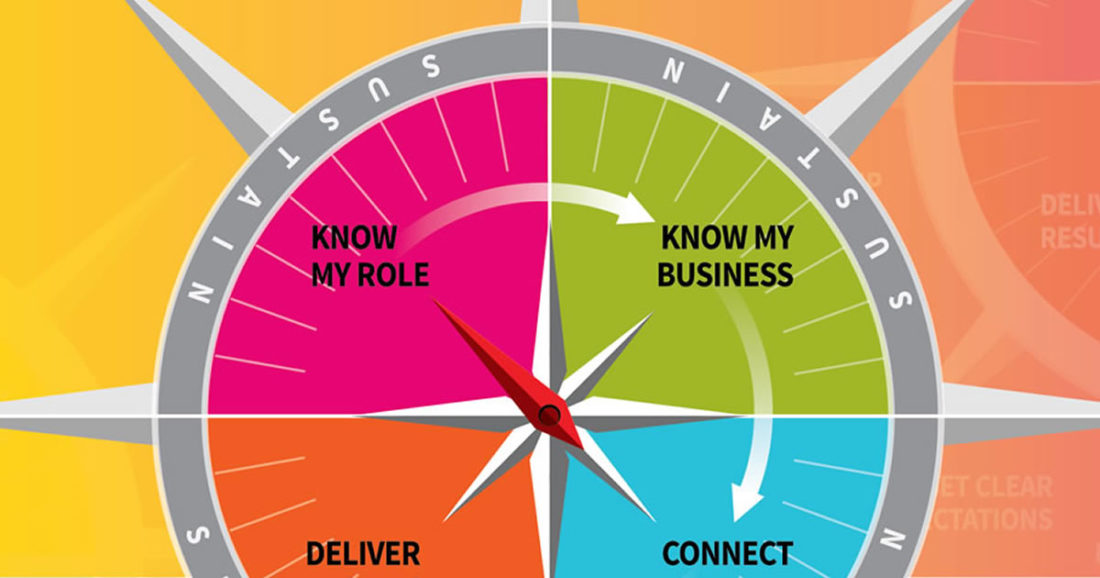How Does a Manager Matter to a Cup of Coffee?
Developing Managers for a Better Customer Experience
We’re all consumers, and we’ve all been the victims of broken promises at the hands of customer service representatives who don’t seem to care or organizations that don’t live up to the service we expect.
For example, let’s pretend there’s a new coffee shop that just opened and you’re eager to try their Brazilian Mocha Cinnamon Caramel Delight. But when you enter the store, all you can smell is cleaning fluid and, to top off this disappointing experience, the baristas and waitstaff are completely ignoring you.
Now, let’s look at this from a business’s perspective.
As the manager or owner of that coffee shop, you’ve expended a sizable portion of your budget on advertising to attract business. Potential customers have seen the well-designed ads, heard the attractive promises, and are enthusiastically ready to buy your products. However, when those prospective customers enter the coffee shop, the reality doesn’t match expectations.
The promises of great service, the focus on pleasing the customer, the welcoming atmosphere – it’s just not there. Your potential customer stands in the doorway as two employees talk and laugh in a corner of the store, and at the register, the cashier busily texts her boyfriend. No one even notices when the customer quietly leaves. And your return on investment just walked out the door.
So what happened in this situation? Your frontline employees just failed you. But it’s probably not their fault. Often, behind their behavior is a manager who was never properly trained to be a good leader.

Intuitively, most organizations understand that the customer can’t be taken for granted, and that it’s more important than ever to ensure that the customer experience matches the promises of the brand.
Yet, surprisingly, human resources leaders say the people who are most critical to this experience – frontline managers – who manage nearly 80% of your workforce are “the ‘least ready’ workgroup in the company, even less capable than their entry-level employees in many cases. One recent study found that people are 40 years old when they first go through leadership development courses – four years after they typically people leaders.
Most frontline managers learned how to manage from another manager and if a strong development program is not in place, people are ‘learning how to lead’ by chance. This is somewhat alarming when you realize they’re talking about the people who, to your customers, are the “face” of your organization.
Businesses need frontline people who are fully equipped and prepared to bring the brand to life through the customer experience. That takes excellent leadership from your frontline managers. After all, within the first five seconds of interacting with your employees, your customer will determine consciously or subconsciously whether your brand or promotion efforts have paid off and to what degree.
Can your organization afford a negative interaction? With social media and “word of mouth” reviews so prevalent, the answer is “no”.

The greatest return on investment
CEB research has found that 60% of new managers underperform in their first two years, with negative consequences for both new manager and direct reports and in another report from Achievers, they found that less than half of managers had been trained in the types of management investigated, with an average of 37% saying they had received at least one type of training. This includes management staples such as one-to-one meetings and more advanced techniques like strength-based management.
So why aren’t frontline managers getting the job done for their organizations? The answer is simple. Frontline managers – who have the greatest influence on the customer experience – simply aren’t being prepared to lead people. In fact, this issue isn’t limited to frontline managers.
Every manager across every function of your organization needs the skills to engage and inspire their teams. When this happens consistently, performance improves, turnover plummets, and customer satisfaction can skyrocket. A well-known Gallup survey pointed out that people don’t leave their companies, they leave their managers.
A myriad of recent surveys have indicated nearly 40 percent of workers are thinking about leaving their jobs. If you couple that level of turnover with an average onboarding cost of $4,100 (US) per employee, evaluating organizational priorities is critical. Having strong managers that can inspire and motivate their people to keep them engaged is not just important, it’s become mission critical.
If these managers are getting training at all, it often isn’t relevant and rarely gives them the skills they need to be successful in the hardest part of their job – leading people. Most managers are selected because they were superior individual workers; they are promoted because they know everything about doing a certain job. It’s less certain, and most often overlooked, whether they know how to effectively lead a team of people and can ensure that the strategy of the organization is brought to life on the front line.
Many times, managers are trained in technical or operational areas that may teach them to file the paperwork correctly, but the human equation is left to chance. Likely, what they really need are interpersonal skills and leadership capability that is developed using techniques that are compelling, memorable, and meaningful to their work. Add to that, they also need to strong capabilities in digital literacy and leading virtual teams.
Plus, it’s rare for frontline managers to clearly articulate the company’s strategy and know their role in bringing it to life. If managers don’t understand and internalize what the company is aiming to achieve and their team’s part in it, and if they can’t motivate and connect their people to it, how will strategy get executed? Marketing may bring the customer in the door, but it’s the customer experience that determines the actual sale and its volume – and whether that customer is interested in coming back.
So if your training isn’t focusing on the “right things,” then most likely your training budget is being wasted.
The multiplier effect and the service profit chain
When organizations neglect to effectively train their managers, it can lead to a cascade of issues that cause other serious challenges, like frontline employees who lack commitment and focus, customers who are receiving indifferent service and have no loyalty, and profits that inevitably sag.
Consider the “multiplier effect.” One poor manager may affect the performance and morale of 10 employees. In the course of one shift , each employee may interact with 30 customers or prospective customers. That means 300 people have interacted with employees who are not being effectively managed. As a result, there is a high probability that these employees are not consistently delivering a stellar customer experience.

Poor managers who don’t feel adequately prepared may also be disengaged themselves, which can negatively impact the business. When it comes to bringing a strategy or initiative to life, they can become the “stoppers” who prevent initiatives and action plans from flowing to frontline employees. They can also be a cause of high turnover, which leads to continuous training, checking, and enforcing of processes and little time for truly “managing.” Worse, high turnover leads to more hiring costs and slashed training budgets.
Effective management equates to internal service quality. In a Harvard Business Review article, “Putting the Service Profit Chain to Work,” the authors show that when internal service quality improves, it leads to increased employee satisfaction, loyalty, and productivity, which leads to customer satisfaction and loyalty, which ultimately leads to growth and profitability.
Service profit chain in practice
The Service Profit Chain begins with internal service quality, which boils down to effective management. When internal service quality and management effectiveness improve, employee satisfaction, retention, and engagement improve.
Engaged employees drive customer satisfaction and engagement, which drives profitability and growth. Each of these links is critical to the chain. As the links are strengthened, profits grow.
Petco is an excellent example of the Service Profit Chain at work. Petco recognized the need to further invest in their frontline managers to provide the leadership skills necessary to engage and inspire their teams and ultimately harness that discretionary effort to deliver better business results. In little more than a year after making an investment in their store managers, Petco enjoyed tremendous results due to manager effectiveness improvements: sales increased during the recession, turnover decreased 35%, employee engagement rose by 9%, and customer loyalty index also increased by 10%.

Developing best practices for an optimal customer experience
The great news is there are ways to turn this situation around. Leveraging a consistent set of manager development best practices to help managers focus on their role in the business can make a huge difference to organizational success. Improved employee engagement, increased customer loyalty and growth, and revenue are all outcomes that can be expected.
Here are four key areas to focus on when you think about preparing your managers for a true leadership position in your organization.
 Managers must know their role.
Managers must know their role.
Most important, a manager’s role is not about shining as an individual or delighting customers – it’s about wowing their people. Think of an organization as an orchestra –its musicians have different competencies, and they all contribute to the performance. Let’s say the orchestra needs a new conductor, so the leadership chooses a very talented instrumentalist – the lead violinist, for example.
However, despite her talent as a violinist, she is ill-prepared to be the conductor. One assignment is about being an expert in a specific area and mastering it. The other is about artfully blending the talents of everyone in the orchestra into a high-performing team. Although the new conductor shone as a violinist, she lacks the skills to interpret the new music that must be played strategically.
So it is with managers. Great individual contributors do not magically become great leaders when the title of “manager” is bestowed on them. It takes aptitude, training, and practice to master what is a very different skill set. Recognize this difference and you’ll ensure that you select, prepare, and support your managers well. And make certain that your managers don’t take personal responsibility for delivering your customer experience.
Their role is to develop and empower their teams to deliver the customer experience. When managers understand the influence they have and actively keep their people and their teams as their top priority, customers will be delighted and business results will follow.
 Managers must know their business.
Managers must know their business.
When top leadership gives managers the opportunity to understand how they connect to the big picture, managers make better choices that positively affect the business. They engage their employees in a way that helps the business work as a system that is striving to deliver the organization’s objectives.
Without this big-picture context, managers are working blind and are unable to align their efforts and their team to the organization’s goals. It sounds obvious and intuitive, but we commonly talk to managers who understand their piece of the puzzle exceptionally well, but not how it connects to other teams, departments, or business units, or how it rolls up to deliver against your organization’s goals. We have to prepare our managers for success by providing them with the big-picture perspective or, to use our puzzle analogy, we have to give them the puzzle box top!
 Managers must know how to connect their team to your business.
Managers must know how to connect their team to your business.
Managers must go beyond understanding the big picture for themselves – they have to translate it for their teams so every single person who reports to them is viscerally connected and vested in your organization’s success. For this to happen, managers must get into the mindset of their employees and understand the basic human tenets that drive engagement.
These “roots of engagement” are universal and are found in all facets of life – at work, at sporting events, pop concerts, social gatherings, and in affinity clubs. Managers can harness this knowledge to engage the hearts, heads, and hands of their teams:
- People want to be part of something bigger than themselves. By association, they feel like they’re part of an effort, a piece of something more substantial than they could ever be alone. They want leaders and managers to demonstrate the organization’s mission, vision, and values so they can see a greater sense of meaning in their work.
- People want to feel a sense of belonging. People have a sense of meaning or validation when they feel that they “fit,” they’re accepted, they’re one of the group. When they’re left out of the loop of information and interactions, they might begin to distrust their managers and can become “actively disengaged” – actually working against the company’s success.
- People want to go on a meaningful journey. We all want to go on some kind of purposeful adventure that matters, and, as a part of moving forward, there’s a feeling of excitement and discovery, and a sense of achieving something worthwhile. Think of your managers as the tour guides – responsible for describing the destination in a way that is compelling and exciting, charting the course, communicating progress, and ensuring that every member of the team knows the role they play in completing the journey.
- People want to know that their contributions make a significant difference. It’s impossible to feel important unless we know we’re unquestionably making an impact in our world and at work.
Managers must take responsibility for ensuring that these basic needs of their employees are fulfilled. When this happens, engagement comes naturally – and customers will notice.
 Managers need polished interpersonal skills to coach and develop their teams to deliver results.
Managers need polished interpersonal skills to coach and develop their teams to deliver results.
Managers often have excellent functional or technical skills honed after years of experience as individual contributors, but they must rapidly master a core set of interpersonal or people skills. Managers don’t need to understand heady management theory; they are better served by grasping, practicing, and applying the basics of human interaction, and then building on this solid foundation.
Core skills include effective communication, building trust, setting clear expectations, coaching, listening, motivating, and empowering their team to deliver. As you consider manager development programs, look for “actionable” curricula that provide practice opportunities and a sustainment component to support managers as they build new skills and capability and to hold them accountable for doing so. The best managers are the best practitioners, not the best academics, and practice really does make perfect!
These four focus areas go way beyond traditional skills training and serve as a solid foundation for managers in customer-focused organizations.

Zappos, the popular online shoe retailer, has given us one of the best examples of how its engagement-focused managers can have a significant but indirect impact on the customer experience. They do this by giving their people a high degree of empowerment and supporting their day-to-day decisions on how best to serve the customer.
At Zappos, rather than measure customer service representatives on the number of calls they take in a day, they focus on delivering great customer service no matter how long that takes. Each customer interaction is seen as an investment in their brand. They are working at creating a lifelong relationship with each customer, one phone call at a time.
Representatives don’t use scripts, and they don’t upsell customers. They are empowered to use their best judgment and let their own personalities shine during every call.
Put managers at the heart of the human experience
When frontline managers focus on the human experience and put their people front and center, they can be game-changers. Well-managed workers become satisfied and engaged employees who more effectively engage and delight customers.
But the first step in this process is for the organization to help managers develop the skills and know-how to connect the front line to the strategy and engage and empower their employees to focus on the priorities of the customer experience.
Once everyone supports the larger organizational goals, the unimportant activities fall away. People begin to put the customer first – not because someone told them that the customer is number one, but because they’ve discovered this for themselves.
This means that the customer is getting that cup of coffee they were so excited about, and with a service level that goes above and beyond their expectations. For your business, that means you’ll have a loyal customer who keeps coming back for more coffee – and next time, maybe even a doughnut.
Insights to Your Inbox







